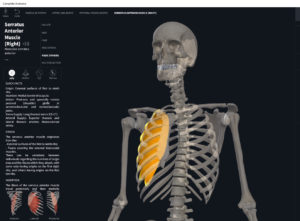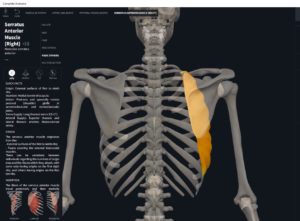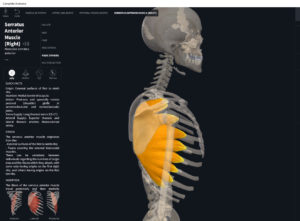Anatomy & Physiology: Muscles—Serratus Anterior.
Structure.
- Origin: ribs 1-8 or ribs 1-9.
- Insertion: vertebral border and inferior angle of scapula.
Function.
- Concentric action: scapular protraction/abduct scapula, elevation, depression, medial tilt, downward tilt, and upward rotation; elevates ribs when scapula is stabilized; “boxer’s muscle” (horizontal arm movements, punching, pushing).
- Reverse mover action: retracts trunk at scapulocostal joint (ScC); depresses trunk at ScC; elevates trunk at ScC.
- Eccentric action: controls/restrains/slows scapular retraction, downward rotation, depresion, elevation, lateral tilt, and upward tilt. Controls/restrains/slows protraction, elevation, and depression of the trunk.
- Isometric action: stabilization of the scapula and stabilization of the rib cage.
- Innervation: long thoracic nerve C5-C7.
- Arterial supply: dorsal scapular artery (branch of subclavian artery), lateral thoracic artery (branch of axillary artery), superior thoracic artery (branch of axillary artery).
Clinical Significance.
References
Biel, A. (2015). Trail guide to the body: A hands-on guide to locating muscles, bones and more.
Cedars-Sinai. (2018). Vertebrae of the spine. Retrieved from https://www.cedars-sinai.org/health-library/diseases-and-conditions/v/vertebrae-of-the-spine.html
Clark, M., Lucett, S., Sutton, B. G., & National Academy of Sports Medicine. (2014). NASM essentials of corrective exercise training. Burlington, MA: Jones & Bartlett Learning.
Jenkins, G., & Tortora, G. J. (2012). Anatomy and Physiology: From Science to Life, 3rd Edition International Stu. John Wiley & Sons.
Muscolino, J. E. (2017). The muscular system manual: The skeletal muscles of the human body.




